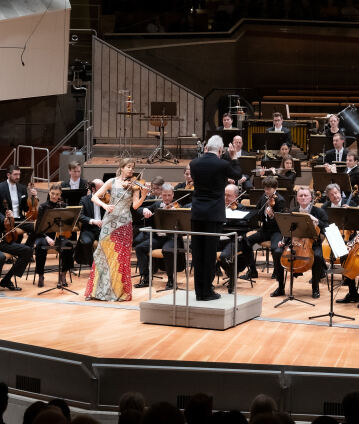Hannu Lintu and Vilde Frang

The Finnish conductor Hannu Lintu comes to his debut with the Philharmoniker as a musical ambassador of his homeland. The chief conductor of the Finnish National Opera presents Kaija Saariaho’s celestial Ciel d’hiver and the austerely Nordic Seventh Symphony by Jean Sibelius. The concert opens with Olivier Messiaen’s Le Tombeau resplendissant and Igor Stravinsky’s highly virtuosic Violin Concerto with soloist Vilde Frang.
Olivier Messiaen never got over the loss of his mother. “My youth is dead... A sea swells at my ears! How it crashes: the void enters into me!”, the 27-year-old noted above his Le tombeau resplendissant (The Illuminated Tomb). The piece begins with piercing sounds and only comes to rest after a bang in the low strings. The inner emptiness gives way to Messiaen’s unconditional trust in divine redemption: “Blessed are the pure in heart.”
Igor Stravinsky provided for his mother, wife, children and mistress for a long time. So in 1931, he demanded an extremely high fee for a violin concerto – and delivered a four-movement concerto full of humour and almost unplayable virtuosity. The work is reminiscent of Baroque models in that the violin often interacts with other orchestral instruments. “These chamber music qualities were the key for me in the interpretation,” says soloist Vilde Frang, who has been a popular guest of the Berliner Philharmoniker since her debut at the Europakonzert in Røros in 2016.
Hannu Lintu conducts works by the Finnish composer Kaija Saariaho as often as possible. Ciel d’hiver (Winter Sky) is an arrangement of a movement from her cycle Orion, composed in 2002. The work creates a dark, evocative fog of sound that flashes with melodic splinters. Saariaho found her personal style through her contact with what is known as the spectral music scene in Paris in the 1970s. Jean Sibelius’s Seventh Symphony was a highly regarded work at the time, with its visions of light in the strings and the striking trombone sounds above them. The symphony was in the composer’s head for ten years before he put it to paper in 1924: a highly concentrated work in just one movement. Sibelius compared it to a river, enriched by countless tributaries, until it “flows majestically towards the sea”.
© 2024 Berlin Phil Media GmbH
Related interviews
Artists
Our recommendations
- Simon Rattle conducts the 2016 Europakonzert in Røros
- Iván Fischer and Vilde Frang present Bartók’s Violin Concerto No. 1
- Kirill Petrenko and Vilde Frang
- Jakub Hrůša conducts Bruckner’s Fourth and a world premiere
- Herbert Blomstedt conducts Schubert and Beethoven
- Britten’s Violin Concerto with Janine Jansen and Daniel Harding